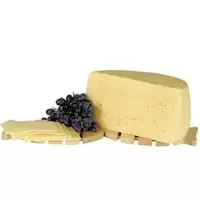Kostroma cheese

The city of Kostroma is one of the pearls of the Russian Federation. The rich history, traditions, architecture and cooking of Kostroma annually attracts up to 120 thousand tourists to the city both from the Russian Federation itself and from foreign countries. Terem Snegurochki, the temple of Bogohranim Kostroma, jewelry, a monument to the Russian national hero Ivan Susanin, linen fabrics and, of course, Kostroma cheeses. This is just a small list of what the city is famous for.
Often it is Kostroma that is called the cheese-making capital of the Russian Federation. And this is not surprising, especially if you turn to the history of cheeses in Russia. The first Russian cheese maker Vereshchagin specially traveled to Switzerland in order to be trained by cheese masters 150 years ago. He also opened the first cheese factory in the Russian Empire. In Kostroma, the first cheese factory opened in 187
8.
In those days, Kostroma cheeses became a delicatessen product on the tables of the elite. Years passed and cheesemakers improved old recipes and created new varieties of Kostroma cheese. The most popular species are Susaninsky, Demidovsky, Voskresensky, Ivan Kupala and Kostroma cheese. Kostroma cheese is considered a hard variety of cheese, for the manufacture of which a rennet enzyme is used.
Like most hard cheeses, Kostroma is produced using a special technology that involves reheating milk, to which the enzyme has already been added and the coagulation process has begun. Kostroma cheese ripens only 45 days, which is relatively small. For example, the average ripening time for hard cheese varieties is 60 days, and elite varieties with mold acquire their unique taste and aroma due to the long ripening time (from 90 days).
Kostroma cheese is a fairly high-calorie product, about 343 Kcal per 100 grams. The mass share of fat in Kostroma cheese is 45%. Cheese is a product that has a high nutritional value for the human body, and Kostroma cheese is no exception. The Kostroma cheese includes useful vitamins of group A and B, and also contains a large amount of milk protein.
Useful amino acids, mineral salts, as well as trace elements and carbonyl compounds make Kostroma cheese an incredibly useful and nutritious product. Kostroma cheese is characterized by its individual moderately sharp cheese taste, in which it is easy to catch sour notes. The aroma of Kostroma cheese is also unique, it is slightly spicy.
Kostroma cheese has a rather plastic consistency. It can be cut easily, since the cheese body is homogeneous. On the section of Kostroma cheese, you can see cheese eyes of a characteristic round or slightly flattened shape. Residents of Kostroma are rightfully proud of their cheeses, so cheese lovers can take a tour of the cheesy places of the city and taste famous varieties. And you can also cheerfully celebrate Maslenitsa in Kostroma and visit the famous cheese week.
Kostroma cheese 343 kKal
Energy value of Kostroma cheese (Ratio of proteins, fats, carbohydrates - ju):
Proteins: 25.6 g (~ 102 kCal)
Fats: 26.1 g (~ 235 kCal)
Carbohydrates: 0 g (~ 0 kCal)
Energy ratio (bj | y): 30% | 68% | 0%
 Español
Español Français
Français Português
Português Русский
Русский 简体中文
简体中文 繁體中文
繁體中文 日本語
日本語 한국어
한국어 العربية
العربية Türkçe
Türkçe Қазақ
Қазақ Deutsch
Deutsch Italiano
Italiano Українська
Українська
